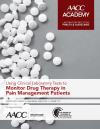
The National Academy of Clinical Biochemistry
Laboratory Medicine Practice Guidelines
Using Clinical Laboratory Tests to Monitor Drug Therapy in Pain Management Patients
Publication Date: 2017
The American Association for Clinical Chemistry (AACC) Academy, formerly the National Academy of Clinical Biochemistry (NACB), has developed a laboratory medicine practice guidelines (LMPG) for using laboratory tests to monitor drug therapy in pain management patients. The scope and purpose of this guideline was to compile evidence-based recommendations for the use of laboratory and point-of-care (POC) urine drug tests for relevant over-the-counter medications, prescribed and non-prescribed drugs, and illicit substances in pain management patients. Current published recommendations from the World Health Organization (WHO) and other medical societies recommend pharmacotherapy using opioids as the mainstay therapy for moderate and severe pain. Unfortunately, these medications pose the risk of addiction and abuse, so monitoring of patients for compliance, or lack thereof, is commonplace. In addition, clinicians in the United States are mindful of the Drug Enforcement Administration’s (DEA’s) efforts to crack down on the growing abuse and deaths related to pain management medications. Therefore, numerous professional organizations, including the Centers for Disease Control and Prevention (CDC), have published recommendations that include the use of urine drug tests to document compliance or assess possible diversion of pain medications. This guideline specifically reviewed the literature to assess and define recommendations regarding the clinical utility and use of urine and alternative specPreamble Using Clinical Laboratory Tests to Monitor Drug Therapy in Pain Management Patients 35 imen types, assorted assay formats (laboratory-based vs. POC), different assay types (screening vs. definitive), inclusion of specimen validity testing and pharmacogenomics testing, as well as the reporting, communication, and interpretation of test results back to clinicians. The intention of this guideline was to provide evidence-based recommendations on how urine drug testing for pain management patients should be performed. Alternatively, in the absence of evidence or only weak evidence, recommendations were based on consensus expert opinion. In the end, the target audience for this guideline was both the laboratories and laboratorians who perform pain management testing and the clinicians who order, use, and interpret these tests. .
PJ Jannetto, N Bratanow, WA Clark, RJ Hamill-Ruth, CA Hammett-Stabler,
MA Huestis, CA Kassed, GA McMillin, SE Melanson, and LJ Langman (editors)